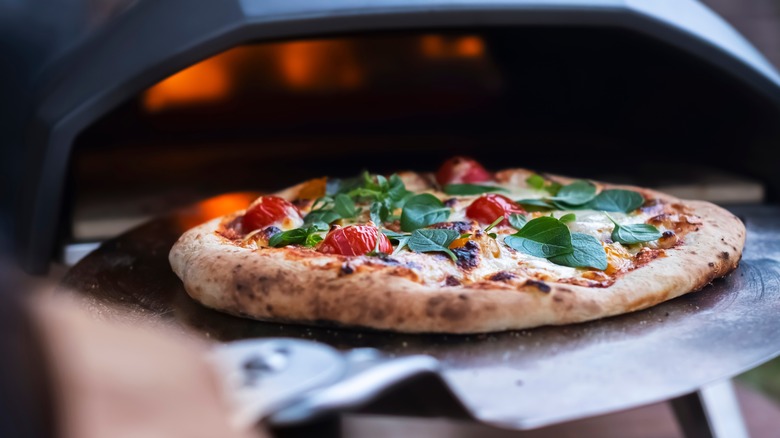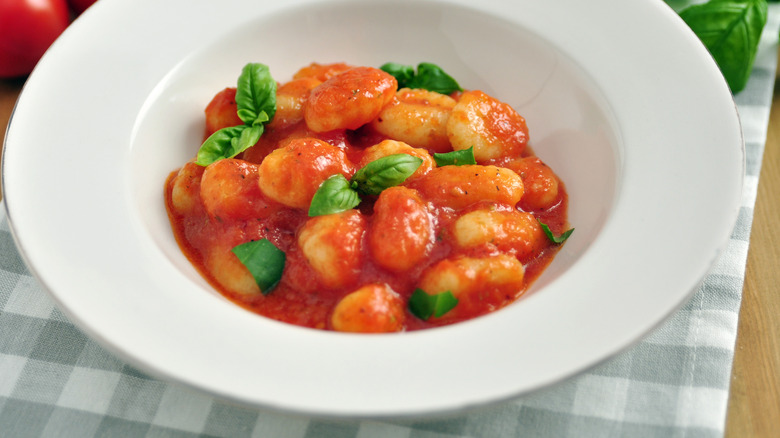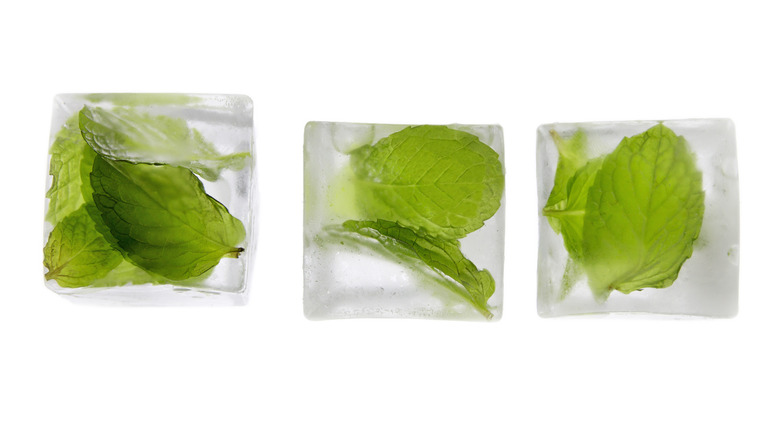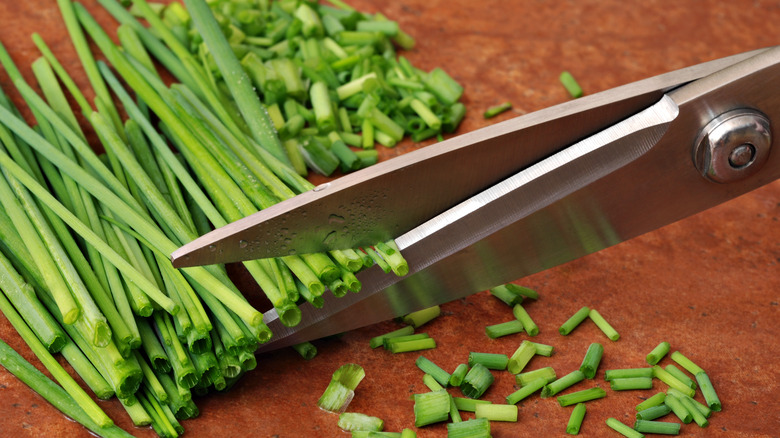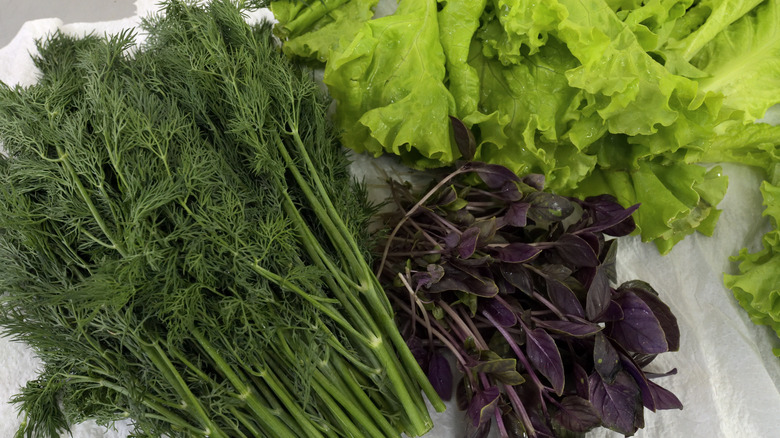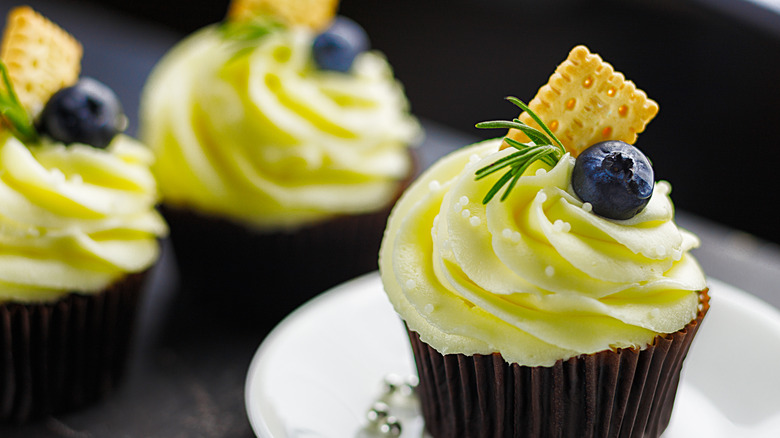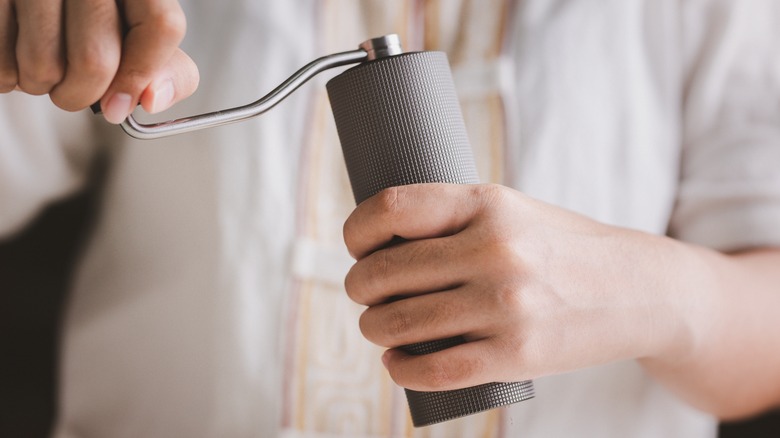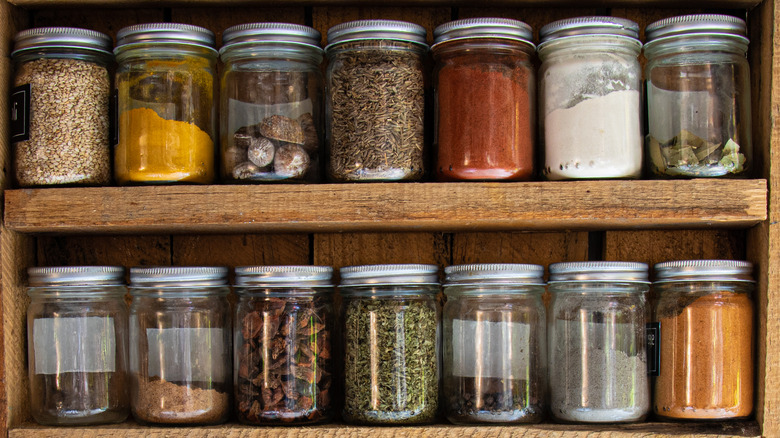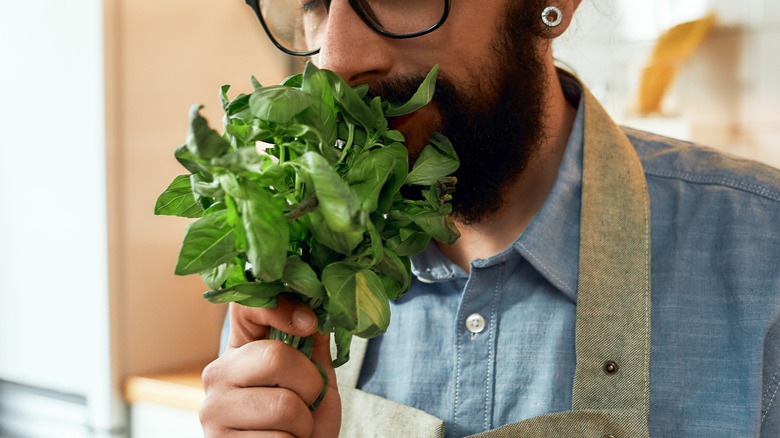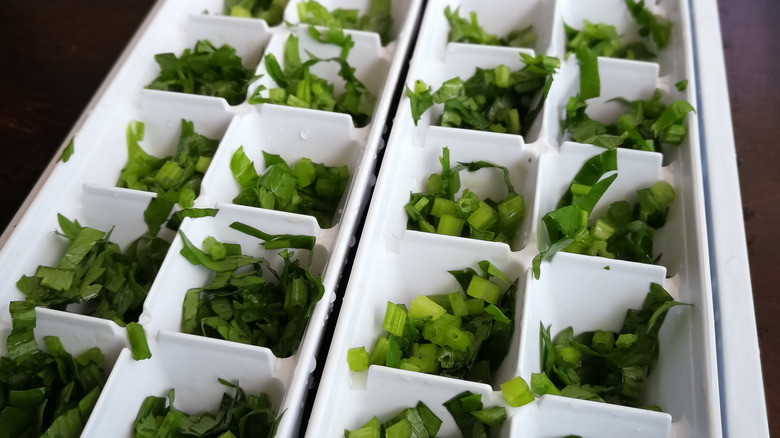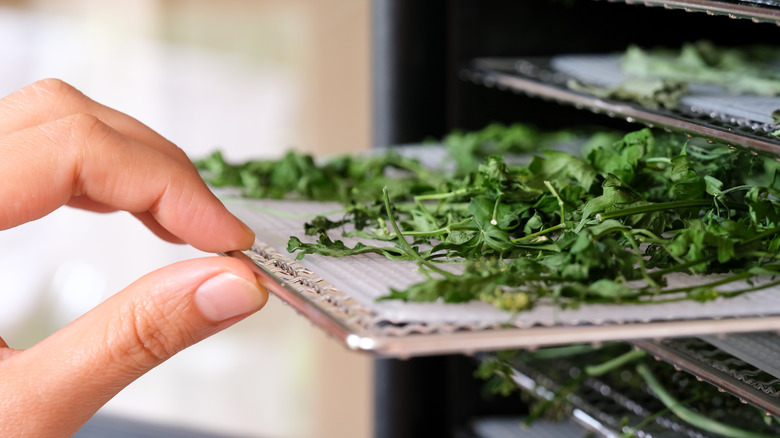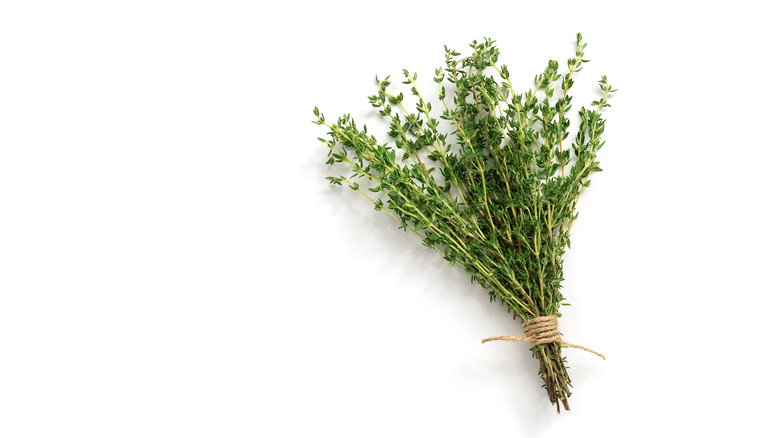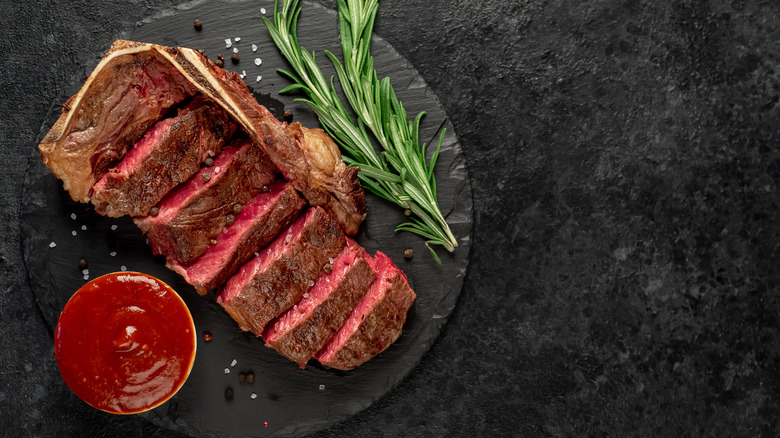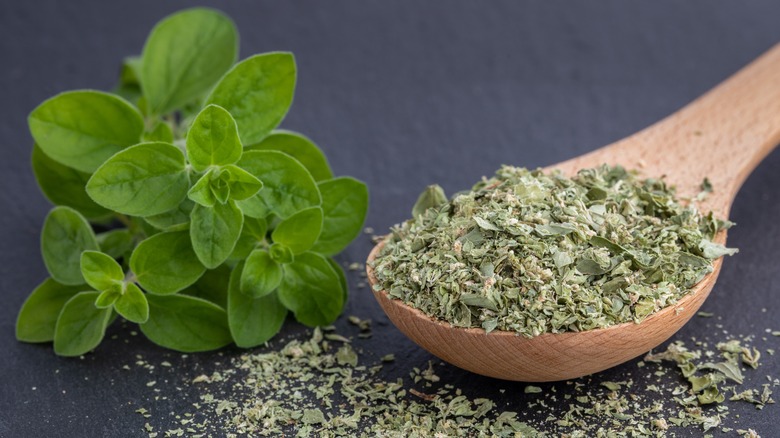14 Tips You Need When Cooking With Herbs
Fresh herbs add a level of both visual and flavorful brightness to even the most mundane of dishes. According to Universal Class, humans have used herbs for thousands of years; the Egyptians and Sumerians recorded trading and selling herbs like marjoram, thyme, and sage in markets in the earliest years of global commerce.
From mint to rosemary and lavender to cilantro, a great variety of herbs are used in food, drink, and everything in between. Culinary herbs are derived from the leaves of nonwoody plants, while medicinal herbs include shrubs and woody plants as well. Often confused with herbs, spices are derived from the other parts of the plant besides the leaves, such as the stem, root, or seed.
Herbs are the boost of fresh flavor that your food needs. As with any cooking skill, working with herbs to add depth and complexity to your dish takes practice. Here are some of our best tips for working with herbs in the kitchen.
Stick to dried herbs for sauces and braises
During the warm months of summer, it can be tempting to add fresh herbs to everything you eat, including your fresh homemade tomato sauce or braising liquid. But you should not neglect the collection of spices inside your kitchen cabinet. While dried herbs can lend a helping hand when fresh herbs are not readily available, there are some applications when dried herbs should be prioritized over fresh ones.
According to The Pioneer Woman, fresh herbs don't pack as much flavor as dried herbs because of the high water content. In a braising liquid, sauce, and the like, you won't get much of the powerful herby undertone that you need — and adding the herbs in early defeats the purpose of the fresh pop of color and flavor. Instead, stick to using fresh herbs as a garnish or for fresh, herby sauces like homemade chimichurri.
Shock fresh herbs in ice water to perk the them up
If you've ever kept herbs around for a few days, you can attest to the limpness of the leaves that may ensue. Using an ice water bath improves not only the texture of the herbs but also the bright, intense colors that make sauces like pesto and chimichurri all the more appealing. This trick, which involves soaking the entire herb in ice water until the texture and color improve, works on herbs that have wilted over several days or ones you just brought home from the grocery store.
Notably, fresher herbs require less time in the bath than older herbs; some herbs may require only a few minutes in the soaking bath. If you use this trick for blending herbs before making a sauce, you'll find that the residual coolness on the surface of the leaves helps keep the blades of the blender or food processor cooler, thus not contributing to a dismally-colored dip or sauce.
Use kitchen shears to chop fresh herbs with ease
If you've ever cleaned your knife after chopping herbs, you know how difficult it is to get every individual fiber of green off the surface of the knife without taking off your finger as well. The easiest way to make quick work of herbs is to use kitchen shears instead of a knife. Place your desired herb into a glass jar and shove the tip of the kitchen shears in, then chop away. You won't have to worry about poking yourself with the shears, nor will you have to clean a cutting board and a knife.
If you want to avoid bruising your herbs, cutting them with kitchen shears is your best bet. One of the biggest reasons herbs bruise when you cut them is that they are already mushy or bent and pressed during cutting. For herbs that require chiffonading, like fresh basil, simply roll the leaf into the cigar shape and cut it with the sharp tip of the scissors at ⅛-inch intervals.
Keep woody herbs alive with a damp paper towel
The way you preserve woody herbs is not the same as tender ones. To determine which kind of herb you have, take a peek at the stem. Dill, parsley, and basil have flexible and tender stems, while rosemary, sage, and lavender are much more rigid. Regardless of the type of herb, it's best to purchase the highest quality herbs you can find. Avoid buying herbs that are soggy or discolored, as these signs indicate that the herbs might already be going bad.
For all types of herbs, you should first rinse the herbs with water, dry them well, and remove any broken or wilted stems from the bunch. For tender herbs, trim the bottoms of the stems, place them in an inch of water, and cover the bundle with a plastic bag. Oxygen is the enemy of the structure of these herbs, so be sure to remove as much air from the bag as possible before sealing. Woody herbs need to be rinsed and wrapped in a wet paper towel for maximum longevity. Then, the woody stems should be sealed in an airtight plastic bag and refrigerated.
Storing your herbs at a stable temperature in your refrigerator will prevent premature mushiness. However, it is best to avoid storing herbs in the back of your refrigerator because it may get too cold.
Savory herbs can be used for sweet applications, too
Modern chefs have blurred the line between savory and sweet — all with the help of herbs. Lavender hot chocolate is a delicious pick-me-up-in-a-cup made by adding a sprinkle of lavender to steamed milk with cocoa powder and sweetener. The inclusion of this herb provides a floral undertone that is still mild enough to pass for sweetness. Fresh rosemary is a vital component in the rosemary cream for an olive oil cake with poached pears. The rosemary adds an organic taste to the dessert that makes the taste of the poached pears sweeter.
Chef Jacques Pépin uses fresh basil in his red summer fruit stew because its savory qualities add a licorice-like undertone to the watermelon, grapes, plum, and blueberry dish. Pépin boils the herb with the fruit in a bundle to infuse the flavor and then discards the herb once the stew is finished cooking. Mint can also provide a bit of organic flavor with an undertone that pairs well with the fruitiness of sweet summer produce.
You can use a coffee grinder to grind dried herbs
If you ever wanted to make your own spice blend at home, you should consult yet another kitchen appliance: your coffee grinder. According to the Herbal Academy, cutting or breaking your herbs into smaller pieces increases the surface area of the herbs. Moreover, a higher surface area infuses more phytochemicals quicker into a broth or a solvent. And while the go-to method for grinding herbs is usually a mortar and pestle, that manual tool is much more time-consuming than its electric counterpart.
The coffee machine you use to grind your herbs may have a burr rather than just the spinning blade — "burr" is the word that describes two abrasive surfaces against one another. If you use the same grinder for your coffee to pulse herbs and spices, you may notice your morning coffee tastes a bit funky. If you don't want to go through the added task of cleaning your coffee grinder every single time, you might consider purchasing two separate grinders: one for your herbs and one for your coffee.
Don't store your herbs near heat
Both herbs and spices need to stay cool to extend their shelf-life to the longest extent possible. You should avoid storing your spices in temperatures greater than 68 F or in environments with greater than 60% relative humidity. According to EatByDate, storing spices in warm and wet spaces accelerates the clumping process. Be sure to store your spices in a pantry space, drawer, or cupboard away from the stove to reduce heat exposure. You can also add silica packets, dried beans, or rice to help absorb any residual moisture and keep your dried spices fresh.
The other reason why you want to store herbs and spices in an enclosed pantry is to keep the products away from sunlight. Light further warms the spices and zaps out the essential oils that give herbs and spices their flavors. So although you may love the look of tiny glass vials of oregano, parsley, and dill in a warm sunny window, your sauces may become lackluster.
If your herbs smell dull, it may be time to throw them out
How long do herbs last? This estimate depends on the type of herb you're working with and how well it was stored. Whole herbs also tend to last longer than fine powders, if you need another reason besides improved flavor to grind and toast your own spices at home. According to Healthline, dried herbs usually last between one to three years.
The good news is that when a herb or spice goes bad, it doesn't tend to cause food-borne illness or sickness. Instead, the herbs will simply be less flavorful, pungent, and colorful than one that is fresh. If you can't find a best-by date on the jar, it is best to crush the herb into the palm of your hand and give it a sniff. If the smell of your herbs is almost undetectable or the flavor is less than desired, it's time to consider tossing out the jar's contents and starting with a new one.
Keep cilantro fresh by freezing it in ice cubes
Cilantro is the backbone of Mexican cooking. This fragrant herb provides a unique punch of flavor to sauces, fresh salads, and spreads, and that's why you should always have some on hand for cooking. However, like other leafy herbs, fresh cilantro doesn't last long.
One of the easiest ways to preserve fresh herbs like cilantro is to take out a plastic ice cube tray and start removing the stems. Chop the leaves, fill each well of the tray halfway with the leaves, and top off the rest of the well with oil. Alternatively, you can freeze herbs that you will use fresh in salads with water instead of oil. Freeze the tray until set and once your cubes are entirely frozen, crack the cubes into a freezer bag for storage. This method works best for the woody-stem herb class, like sage and rosemary. Soft, tender herbs may need a quick blanch before freezing to maximize color and flavor over time.
Dry herbs in the microwave in a pinch
If you grow a lot of herbs in your garden or on the kitchen countertop, you've probably felt obligated to learn how you can dry your leaves to use them at a later time. The same can be said if you buy a plastic pack of thyme at the store and only use half of it for your sauce.
The microwave can be your hidden weapon for drying herbs in a pinch. If you're working with a woody stem, you don't have to worry about separating the herb from the stem. Clean and dry your herbs with a kitchen towel before microwaving them in 15- to 30-second intervals until fragrant; larger herbs will take more time to dry than smaller ones. Once your herbs are dry, you can place the herbs in an airtight container for up to six months until you are ready to use them for a homemade tomato sauce or beef bourguignon. You can test the herbs for freshness by crumbling a bit between your fingers and checking for a fragrance.
Don't discount herbs in your cocktails
Herbs are not just for cooking. Experienced mixologists use herbs to impart contrasting flavors to their specialty-crafted beverages and cocktails. Some mojito recipes include a sweet mint syrup made by dissolving sugar into the water with a few mint leaves. This method preserves the flavor of the mint over a longer period of time (a week or two in the fridge). You should also leave a couple of mint sprigs in your refrigerator to garnish your refreshing summer beverage of choice. If you like the flavor of basil more than mint, you can make a luau basil rum cocktail with muddled basil leaves and St.Germain, rum, and soda water.
You can make your basil garnish extra special by candying the basil leaves with sugar and egg whites, too. You won't even need to cook the basil leaves down — simply brush the leaves with egg whites, roll them in sugar, and allow the leaves to harden for about an hour. You'll get a delicious pop of flavor and color with this simple herb technique.
Make a herb bundle instead of chopping herbs
A lot of time is spent chopping herbs in the kitchen. Chef and TV personality Rachael Ray recommends saving some time working with herbs by infusing your soups and broths with a bundle of herbs instead of freshly chopped ones. She suggests tightly tying the stems of your favorite herbs — including sage, thyme, or oregano — together with kitchen twine before tossing the herbs wherever you need to. This technique mimics the bouquet garni, which usually contains parsley, bay leaves, and thyme, but with more flexibility on the various kinds of herbs you can use.
If you are worried about how your herbs will hold together in a rolling boil, you can boil the herbs in a piece of cheesecloth tied with kitchen twine instead. The cheesecloth is porous enough to allow the warm liquid to enter while stopping tiny pieces of herbs from floating away into the sunset.
Strip fresh herbs with a colander
Stripping herbs is yet another of the most time-consuming parts of working with herbs in the kitchen. This step is necessary for removing the stem from woody herbs like rosemary or thyme. The majority of home cooks strip the herbs by holding the stem with one hand and gently tugging at the herbaceous leaves with the other. For some fragile herbs, this method merely breaks up the herb and scatters tiny leaves around your kitchen.
As suggested by food media star Giada De Laurentiis, an alternative to this common method is to string the herbs inside of a colander and pull the herbs inward. This approach keeps the leaves neatly in the colander bowl and will only take a matter of seconds. And, with all the extra time you'll have on your hands, you can discover other recipes where you can infuse even more herbs into your cooking.
Use a 1-to-3 ratio of dried to fresh herbs
Many recipes will deliberately indicate if fresh or dried herbs are needed. This difference is imperative because ground, dried herbs and fresh herbs pack two different levels of flavor. The standard substitution ratio is one teaspoon of dried herbs for each tablespoon of fresh herbs. The exception to this rule is bay leaves. You should use two dried bay leaves for each fresh one because the herb loses flavor very quickly when dried. That means you can use half a dried bay leaf if your recipe requires a whole fresh bay leaf.
Beyond the amount of herbs you use in a recipe, you should also pay attention to when you add those herbs to the dish. While dried herbs are a bit more forgiving if added early in the cooking process, adding fresh herbs more than a half-hour from when you plan to serve the dish may result in bitter notes. Stick to garnishing with fresh herbs right before serving for a bright punch of color and fresh contrast in your favorite recipe.
